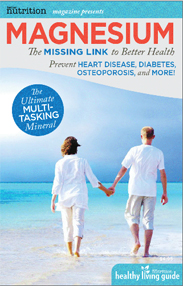Sports Nutrition – Magnesium and Energy Nutrition
Exercisers who feel weak and tired may be suffering from “the mineral blues,” says Gabe Mirkin, M.D., coauthor of the Sportsmedicine Book.
The mineral blues are characterized as a deficiency of potassium and magnesium inside muscle cells, according to “The Complete Book of Vitamins and Minerals for Health”. “A loss of magnesium through sweat can bring fatigue and muscle cramps because of the role the mineral plays in controlling muscle contraction and regulating the conversion of carbohydrates to energy,” the publication stated.
In foods, potassium and magnesium can be found in nuts, soybeans, whole grains, fruits and vegetables.
Athletes, body builders, runners and those who perform strenuous exercise or physical work are advised to make sure their cellular magnesium levels are up to par, reported Eberhard Kronhausen, Ed.D., et al., in “Formula for Life: The Antioxidant, Free-Radical Detoxification Program”.
“Magnesium is responsible–together with calcium–for the production of adenosine triphosphate (ATP), our most important high-energy phosphate compound,” the authors added. “In addition, good magnesium levels are needed for optimal muscle contraction and to sustain the high oxygen consumption necessary for athletic performance. Research indicates that magnesium facilitates oxygen delivery to working muscle tissue…”
In addition to its contribution to multiple enzyme systems, including ATP metabolism in the production of energy, magnesium plays a role in protecting us against ischemic heart disease, myocardial infarction, cardiac arrhythmias, high blood pressure, asthma, preeclampsia and alcohol withdrawal, according to Robert M. McLean, M.D., of the Yale School of Medicine in New Haven, Conn., in the January 1994 issue of “The American Journal of Medicine”.
He went on to say that the amount of magnesium in the blood does not necessarily correlate with the amount of the mineral stored in the body, making a magnesium deficiency difficult to pinpoint. Low magnesium levels are rather common problems found in about 65 percent of intensive care patients and about 11 percent of the general patient population, he said.
Magnesium levels can be depleted by such drugs as amphotericin B, cyclosporine, cisplatin, digojcin, ethanol, gentamicin, loop diuretics and pentamidine, he added.
A combination of magnesium and malic acid (extracted from apples and other foods) has been useful in treating some patients with chronic fatigue syndrome, reported the Spring 1993 issue of Health Watch, a publication of the Chronic Fatigue Syndrome Research Foundation in Santa Barbara, Calif.
Daniel Peterson, M.D., said that the combination of the mineral and malic acid benefits up to 40 percent of the patients with chronic fatigue syndrome. Malic acid should be included in the therapy for these patients, added Jay Goldstein, M.D.
The researchers indicate that fibromyalgia (associated with muscle and bone aches, pins-and-needles feelings, fatigue, tension headaches, insomnia, etc.) may not respond to the magnesium-malic supplement for 48 hours. For chronic fatigue syndrome, this therapy may take two weeks, they said.
In addition to contributing to ATP production, malic acid is important in the Krebs cycle, in which fats and sugar are converted into energy, the researchers continued.
The therapeutic dose that they recommend for patients is six to 12 tablets/day of malic acid and magnesium hydroxide. The supplement is to be taken with food and water.
“Those who exercise strenuously need magnesium because it helps deliver oxygen to the muscles for peak performance,” according to Rita Aero and Stephanie Rick in Vitamin Power.
Magnesium is vital for converting glycogen into glucose for use as the body’s fuel.”
REFERENCES:
Aero, Rita, and Rick, Stephanie. Vitamin Power. New York: Harmony Books, 1987, p. 159.
“A Follow-up on Malic Acid: CFIDS Buyers Club,” Health Watch 3(1):1,3, Spring 1993.
The Complete Book of Vitamins and Minerals for Health, Emmaus, Pa.: Rodale Pres, 1988, p. 450.
Kronhausen, Eberhard, Ed.D., et al. Formula for Life: The Antioxidant, Free-Radical, Detoxification Program. New York: William Morrow Co., Inc., 1989, p. 168.
McLean, Robert M., M.D. “Magnesium and Its Therapeutic Uses: A Review”, The American Journal of Medcine 96:63-76, January 1994.
il v57, Better Nutrition for Today’s Living, July 1995, p28(1).
Newsletter
![]()

Want valuable information regarding the health benefits of magnesium, latest studies, expert interviews,videos and health tips? Enter your name and email address and you can start receiving valuable health information right away.
Featured On:








